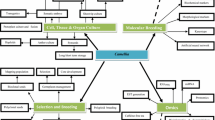Abstract
Tea, which has many sanitarian functions, is one of the most popular non-alcoholic soft and healthy beverages in the world. In many countries, as well as in China, tea (Camellia sinensis) is an important cash crop. It has great value as a source of secondary metabolic products. Molecular biology of tea plants has been one of the most active and kinetic research fields of tea science for the last decade. Isolation and cloning of important functional genes of tea plants have a critical significance on elucidating the molecular mechanism of high quality, yield and resistance, as well as genetic manipulating via biotechnological approaches for tea plants. In this paper, we introduced the research progress on the isolation and cloning of functional genes in tea plants. In addition, the brief prospect on the research of functional genes of tea plants in the near future is also give out.
Similar content being viewed by others
References
Chen L, Zhao L P, Gao Q K (2005). Generation and analysis of expressed sequence tags from the tender shoot cDNA library of tea plant (Camellia sinensis). Plant Science, 168: 359–363
Edwards J W, Walker E L, Coruzzi G M (1990). Cell-specific expression in transgenic plants reveals nonoverlapping roles for chloroplast and cytosolic glutamine synthetase. Proceedings of the National Academy of Sciences of the United States of America, 87: 3459–3463
Feng Y F, Liang Y R (2001). Cloning and sequencing of S-adenosylmethionine synthetase gene in tea plant. Journal of Tea Science, 21(1): 21–25 (in Chinese)
Kato M, Mizuno K, Crozier A, Fujimura T, Ashihara A (2000). Caffeine synthase gene from tea leaves. Nature, 406: 956–957
Kato M, Mizuno K, Fujimura T, Iwama M, Irie M, Corzier A, Ashihara H (1999). Purification and characterization of caffeine synthase from tea leaves. Plant Physiology, 120: 579–586
Li Y H, Jiang C J, Wan X C (2004a). Study on the expression of caffeine synthase gene mRNA in tea plant. Journal of Tea Science, 24(1): 23–28 (in Chinese)
Li Y H, Jiang C J, Yang S L, Yu Y B (2004b). β-glucosidase cDNA cloning in the tea(Camellia sinensis) and its prokaryotic expression. Journal of Agricultural Biotechnology, 12(6): 625–629 (in Chinese)
Matsumoto S, Takeuchi A, Hayatsu M (1994). Molecular cloning of phenylalanine ammonia-lyase cDNA and classification of varieties and cultivars of tea plants (Camellia sinensis) using the tea PAL cDNA probe. Theoretical and Applied Genetics, 89: 671–675
Mizutani M, Nakanishi H, Ema J, Ma S J, Noguchi E, Inohara-Ochiai M, Fukuchi-Mizutani M, Nakao M, Sakata K (2002). Cloning of β-primeverosidase from tea leaves, a key enzyme in tea aroma formation. Plant Physiology, 130: 2164–2176
Mondal T K, Bhattacharya A, Ahuja P S, Chand P (2001). Transgenic tea [Camellia sinensis (L.) O. Kuntze cv. Kangral Jat] plants obtained by Agrobacterium-mediated transformation of somatic embryos. Plant Cell Reporters, 20(8): 712–720
Park J S, Kim J B, Hahn B S, Kim K H, Ha S H, Kim J B, Kim Y H (2004). EST analysis of genes involved in secondary metabolism in Camellia sinensis (tea), using suppression subtractive hybridization. Plant Science, 166: 953–961
Schuler G D (1997). Pieces of the puzzle: Expressed sequence tags and the catalog of human genes. Journal of Molecular Medicine, 75: 694–698
Sugiyama T, Sadzuka Y (1999). Combination of theanine with doxorubicin inhibits hepatic metastasis of M5076 ovarian sarcoma. Clinical Cancer Research, 5(2): 413–416
Takeo T (1981). Production of in linalool and geraniol by hydrolytic breakdown of bound forms in disrupted tea shoots. Phytochemistry, 120(9): 2145–2147
Takeuchi A, Matsumoto S, Hayatsu M (1994a). Chalcone synthase from Camellia sinensis isolation of the cDNAs and the organ-specific and sugar-responsive expression of the genes. Plant Cell Physiology, 35(7): 1011–1018
Takeuchi A, Matsumoto S, Hayatsu M (1994b). Amplification of β-tubulin cDNA from Camellia sinensis by PCR. Bull Natl Res Inst Veg Ornam Plants & Tea, Japan (B), 7: 13–20
Takeuchi A, Matsumoto S, Hayatsu M (1995). Effects of shading treatment on the expression of the genes for chalcone synthase and phenylalanine ammonia-lyase in tea plant (Camellia sinensis). Bull Natl Res Inst Veg Ornam Plants & Tea, Japan (B), 8: 1–9
Wang C X, Li Y Y, Jiang C J, Yu Y B (2005). Molecular cloning and sequence analysis on cDNA of cystatin gene from tea leaves. Journal of Tea Science, 25(3): 177–182 (in Chinese)
Wei C L, Jiang C J, Tao H Z, Wan X C (2003). Cloning and bioinformatics analysis of sequence signature of violaxanthin de-epoxidase cDNA in tea plant (Camellia sinensis (L.) O. Kuntze). Journal of Nanjing Agricultural University, 26(1): 14–19 (in Chinese)
Wei C L, Jiang C J, Tao H Z, Wan X C (2004). Site-directed mutation of violaxanthin de-epoxidase from tea plant (Camellia sinensis) in vitro and expression bio-activity assay of the mutants. Chinese Journal of Biochemistry and Molecular Biology, 20(1): 73–78 (in Chinese)
Wu S, Liang Y R, Lu J L, Li H Y (2005). Combination of particle bombardment-mediated and Agrobacterium-mediated transformation methods in tea plant. Journal of Tea Science, 25(4): 255–264 (in Chinese)
Zhao D, Liu Z S, Xi B (2001). Cloning and alignment of polyphenol oxidase cDNA of tea plant. Journal of Tea Science, 21(2): 94–98 (in Chinese)
Zhao L P, Chen L, Wang X C, Yao M Z (2006). Quantitative detection of β-glucosidase and β-primeverosidase gene expressions in different leaves of tea plant (Camellia sinensis) by real-time PCR analysis. Journal of Tea Science, 26(1): 11–16 (in Chinese)
Author information
Authors and Affiliations
Corresponding author
Additional information
__________
Translated from Molecular Plant Breeding, 2006, 4(3S): 16–22 [译自: 分子植物育种]
About this article
Cite this article
Ma, C., Chen, L. Research progress on isolation and cloning of functional genes in tea plants. Front. Agric. China 1, 449–455 (2007). https://doi.org/10.1007/s11703-007-0074-z
Issue Date:
DOI: https://doi.org/10.1007/s11703-007-0074-z




